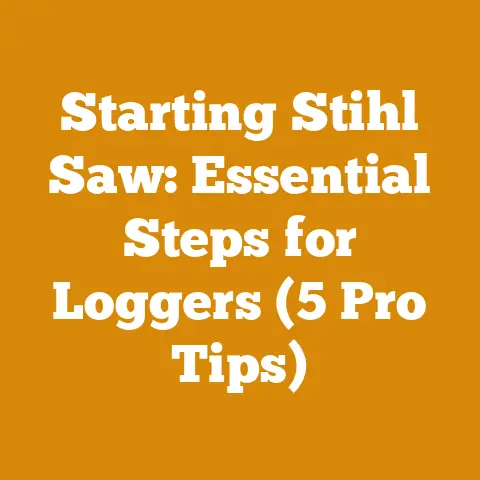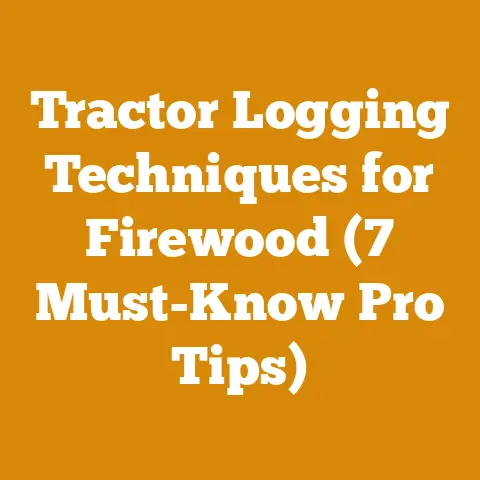How to Clear Underbrush in Woods (5 Pro Logging Techniques)
Okay, let’s dive into the world of underbrush clearing.
You might think it’s just about tidying up the woods, but trust me, it’s so much more.
I’m going to share some pro logging techniques that not only clear your land but also unlock hidden benefits you probably haven’t even considered.
Unveiling the Hidden Benefits of Underbrush Clearing
Think of underbrush clearing as an investment, not just a chore.
It’s about forest health, safety, and even future profits.
Let me tell you a story.
Years ago, I worked on a neglected woodland property.
The undergrowth was so thick, you could barely walk through it.
After clearing it, the difference was remarkable.
Sunlight reached the forest floor, encouraging new growth of desirable species.
We reduced the risk of wildfires, and suddenly, the property became much more accessible for timber harvesting and recreational use.
Here are some of the hidden benefits you might not immediately think about:
- Improved Forest Health: Removing dense undergrowth allows sunlight to reach the forest floor, promoting the growth of desirable tree species and wildflowers.
It also reduces competition for resources like water and nutrients. - Reduced Wildfire Risk: Dry underbrush is a major fire hazard.
Clearing it significantly reduces the risk of wildfires spreading rapidly. - Enhanced Wildlife Habitat: While it might seem counterintuitive, clearing underbrush can actually improve wildlife habitat.
It creates a mosaic of different habitat types, providing food and shelter for a wider variety of animals. - Increased Timber Value: Clearing underbrush makes it easier to access and manage your timber resources.
It also promotes the growth of higher-value trees. - Improved Accessibility and Aesthetics: A cleared woodland is simply more enjoyable to walk through and spend time in.
It also increases the property’s aesthetic appeal.
Now, let’s get into the nitty-gritty of how to do it.
These are the techniques I’ve learned and perfected over years of working in the woods.
1. Chainsaw Mastery: Felling Small Trees and Brush
This is the cornerstone of underbrush clearing.
A chainsaw, in the right hands, is a powerful and efficient tool.
Choosing the Right Chainsaw
- For light underbrush (saplings under 4 inches in diameter): A lightweight chainsaw with a 14-16 inch bar is ideal.
I recommend something in the 35-45cc range.
Brands like Stihl, Husqvarna, and Echo are known for their reliability.
I personally prefer Stihl for their durability in demanding conditions. - For heavier brush (trees up to 8 inches in diameter): You’ll need a more powerful chainsaw with a 16-20 inch bar.
Look for something in the 50-60cc range. - Battery-powered chainsaws: These are becoming increasingly popular, especially for smaller jobs.
They’re quieter, lighter, and require less maintenance than gas-powered chainsaws.
However, they may not be as powerful or have as long of a run time.
I’ve found that the higher voltage models (56V+) from brands like EGO and Stihl offer impressive performance. - Safety Features: Always prioritize safety.
Make sure your chainsaw has a chain brake, a throttle lock, and a chain catcher.
Essential Safety Gear
- Chainsaw Chaps: These are a must-have.
They’re designed to stop the chain in the event of a kickback. - Eye Protection: Safety glasses or a face shield are essential to protect your eyes from flying debris.
- Hearing Protection: Chainsaws are loud. Wear earplugs or earmuffs to protect your hearing.
- Gloves: Sturdy work gloves will protect your hands from cuts and abrasions.
- Steel-toed Boots: Protect your feet from falling branches and other hazards.
- Helmet: A helmet with a face shield and ear protection is the ultimate in chainsaw safety.
Felling Techniques for Small Trees
The Bore Cut: This technique is useful for felling trees that are leaning in a particular direction.
- Assess the Lean: Determine the direction the tree is leaning.
You want the tree to fall in that direction. - Make the Undercut: Make a notch on the side of the tree in the direction you want it to fall.
The notch should be about 1/3 of the tree’s diameter. - Bore Cut: Carefully insert the tip of the chainsaw into the tree behind the notch.
Push the saw straight in, being careful not to pinch the bar. - Cut the Hinge: Once you’ve bored through the tree, pivot the saw to cut the hinge.
The hinge is the uncut wood that will control the fall of the tree. - Final Cut: Make a final cut from the back of the tree towards the hinge.
The tree should fall in the direction of the notch.
- Assess the Lean: Determine the direction the tree is leaning.
The Open Face Felling Cut: This is a simpler technique that’s suitable for smaller trees.
- Assess the Lean: Determine the direction the tree is leaning.
- Make the Undercut: Make a notch on the side of the tree in the direction you want it to fall.
The notch should be about 1/3 of the tree’s diameter. - Back Cut: Make a back cut on the opposite side of the tree, slightly above the notch.
Leave a hinge of uncut wood to control the fall of the tree. - Final Cut: Continue the back cut until the tree falls.
De-limbing and Bucking
- De-limbing: Remove the branches from the felled tree.
Start from the base of the tree and work your way up.
Be careful of spring poles (branches that are bent under tension). - Bucking: Cut the tree into manageable lengths for removal or firewood.
Consider the size of your wood stove or the capacity of your truck when determining the length of the cuts.
I typically buck firewood into 16-inch lengths.
Chainsaw Maintenance
- Sharpening the Chain: A sharp chain is essential for safe and efficient cutting.
Use a chainsaw file to sharpen the chain regularly.
I sharpen my chain after every tank of gas. - Cleaning the Air Filter: A dirty air filter can reduce the chainsaw’s performance.
Clean the air filter regularly with compressed air or soap and water. - Checking the Spark Plug: A fouled spark plug can cause the chainsaw to run poorly or not start at all.
Check the spark plug regularly and replace it if necessary. - Lubricating the Bar and Chain: Use chainsaw bar and chain oil to lubricate the bar and chain.
This will reduce friction and wear.
I use a biodegradable bar and chain oil to minimize environmental impact.
Case Study: I was once clearing a patch of overgrown alder trees with a 16-inch chainsaw.
The alder was dense, and the chainsaw chain kept getting dull.
I realized I needed to sharpen the chain more frequently and adjust my cutting technique to avoid hitting the ground.
By doing so, I was able to significantly increase my productivity and reduce the amount of time it took to clear the area.
2. Brush Cutters and Clearing Saws: The Versatile Workhorses
Brush cutters and clearing saws are ideal for clearing dense undergrowth, especially in areas where a chainsaw might be too unwieldy or dangerous.
These tools use a rotating blade or string head to cut through vegetation.
Types of Brush Cutters
- String Trimmers (Weed Whackers): These are best for light-duty work, such as trimming grass and weeds around trees and fences.
- Blade Brush Cutters: These use a metal blade to cut through thicker vegetation.
They’re more powerful than string trimmers and can handle saplings up to a few inches in diameter. - Clearing Saws: These are the most powerful type of brush cutter.
They use a circular saw blade to cut through trees up to 8 inches in diameter.
Clearing saws are typically used by professional loggers and foresters.
Choosing the Right Brush Cutter
- For light undergrowth (grass, weeds, small saplings): A string trimmer or a blade brush cutter with a small blade is sufficient.
- For heavy undergrowth (thick brush, saplings up to 4 inches in diameter): A blade brush cutter with a larger blade or a clearing saw is necessary.
- Power Source: Brush cutters are available with gas, electric, or battery power.
Gas-powered brush cutters are the most powerful, but they’re also the loudest and require more maintenance.
Electric and battery-powered brush cutters are quieter and easier to maintain, but they may not be as powerful.
Safety Precautions
- Wear appropriate safety gear: This includes eye protection, hearing protection, gloves, and sturdy boots.
- Clear the area of obstacles: Before starting, remove any rocks, branches, or other obstacles that could be thrown by the blade.
- Use the correct blade for the job: Using the wrong blade can be dangerous and can damage the brush cutter.
- Be aware of your surroundings: Pay attention to your surroundings and be aware of any people or animals that may be nearby.
- Take breaks: Brush cutting can be strenuous work. Take breaks to avoid fatigue.
Techniques for Using Brush Cutters
- Swinging Motion: Use a smooth, swinging motion to cut through the vegetation.
Avoid jerking or forcing the brush cutter. - Overlapping Cuts: Overlap your cuts to ensure that you’re cutting all of the vegetation.
- Cutting Direction: Cut in the direction that the vegetation is leaning.
This will make it easier to cut and will reduce the risk of the blade getting stuck. - Cutting Height: Adjust the cutting height to avoid scalping the ground.
Personal Experience: I once used a brush cutter to clear a large area of blackberry bushes.
The blackberry bushes were so thick that I couldn’t even see the ground.
It was a challenging job, but the brush cutter made it possible.
I learned the importance of wearing appropriate safety gear and taking breaks to avoid fatigue.
3. Axes and Hand Tools: Precision and Control
While power tools are great for large-scale clearing, axes and hand tools offer precision and control for smaller tasks or areas where power tools are impractical.
Types of Axes
- Felling Axe: This is a large, heavy axe used for felling trees.
It has a long handle and a wide head. - Splitting Axe: This is a specialized axe used for splitting firewood.
It has a wedge-shaped head that helps to split the wood. - Hatchet: This is a small, lightweight axe that’s used for a variety of tasks, such as chopping small branches and kindling.
Other Useful Hand Tools
- Loppers: These are long-handled pruning shears used for cutting branches up to 2 inches in diameter.
- Pruning Saw: This is a small saw used for cutting branches.
It’s more efficient than loppers for cutting larger branches. - Bow Saw: This is a larger saw used for cutting logs and firewood.
- Machete: This is a long, heavy knife used for cutting through thick vegetation.
- Brush Hook: This is a tool with a curved blade used for clearing brush and small trees.
Techniques for Using Axes and Hand Tools
- Stance: Stand with your feet shoulder-width apart and your knees slightly bent.
- Grip: Grip the axe handle firmly with both hands.
- Swing: Swing the axe in a smooth, controlled motion.
- Target: Aim for the point where you want to cut.
- Follow Through: Follow through with your swing, allowing the axe to do the work.
Safety Considerations
- Wear appropriate safety gear: This includes eye protection, gloves, and sturdy boots.
- Clear the area of obstacles: Before starting, remove any rocks, branches, or other obstacles that could be tripped over.
- Be aware of your surroundings: Pay attention to your surroundings and be aware of any people or animals that may be nearby.
- Take breaks: Axe work can be strenuous. Take breaks to avoid fatigue.
Case Study: I was once clearing a small area of brush with an axe.
I was working too quickly and didn’t pay attention to my surroundings.
I swung the axe and accidentally hit a rock.
The axe bounced back and nearly hit my leg.
I learned a valuable lesson about the importance of safety when using axes.
4. Controlled Burning: A Powerful Tool for Large Areas
Controlled burning is a powerful tool for clearing large areas of underbrush.
However, it’s important to note that controlled burning is not legal in all areas.
You’ll need to check with your local authorities to see if it’s permitted in your area.
Benefits of Controlled Burning
- Efficient: Controlled burning can clear large areas of underbrush quickly and efficiently.
- Cost-effective: Controlled burning is a relatively inexpensive way to clear underbrush.
- Ecological Benefits: Controlled burning can have ecological benefits, such as reducing the risk of wildfires and promoting the growth of certain plant species.
Risks of Controlled Burning
- Fire Hazard: Controlled burning can be dangerous if it’s not done properly.
There’s a risk of the fire spreading out of control. - Air Pollution: Controlled burning can produce smoke and air pollution.
- Damage to Property: Controlled burning can damage property if the fire spreads out of control.
Planning a Controlled Burn
- Obtain Permits: Before starting a controlled burn, you’ll need to obtain any necessary permits from your local authorities.
- Develop a Burn Plan: A burn plan is a detailed plan that outlines how you’ll conduct the controlled burn safely and effectively.
The burn plan should include information about the location of the burn, the weather conditions, the type of vegetation to be burned, and the safety precautions that will be taken. - Prepare the Site: Before starting the burn, you’ll need to prepare the site by creating firebreaks around the perimeter of the area to be burned.
Firebreaks are cleared areas that will prevent the fire from spreading. - Notify Neighbors: Notify your neighbors that you’ll be conducting a controlled burn.
Conducting a Controlled Burn
- Choose the Right Weather Conditions: The best weather conditions for a controlled burn are cool, calm, and humid.
Avoid burning on windy days or when the humidity is low. - Start Small: Start the burn in a small area and gradually expand it.
- Monitor the Fire: Monitor the fire closely and be prepared to extinguish it if it starts to spread out of control.
- Have Water Available: Have plenty of water available to extinguish the fire if necessary.
- Extinguish the Fire Completely: Make sure the fire is completely extinguished before leaving the site.
Important Note: I am providing this information for informational purposes only.
I am not responsible for any damages or injuries that may result from conducting a controlled burn.
Consult with a qualified professional before conducting a controlled burn.
5. Herbicide Application: Targeted Vegetation Control
Herbicide application can be an effective way to control unwanted vegetation.
However, it’s important to use herbicides responsibly and to follow all label instructions carefully.
Types of Herbicides
- Selective Herbicides: These herbicides kill specific types of plants while leaving other plants unharmed.
- Non-Selective Herbicides: These herbicides kill all types of plants.
- Systemic Herbicides: These herbicides are absorbed by the plant and transported throughout the plant.
- Contact Herbicides: These herbicides kill only the parts of the plant that they come into contact with.
Choosing the Right Herbicide
- Identify the Target Vegetation: Before choosing an herbicide, you’ll need to identify the types of plants that you want to control.
- Consider the Environmental Impact: Choose an herbicide that has a minimal impact on the environment.
- Read the Label Instructions: Read the label instructions carefully before using any herbicide.
Applying Herbicides Safely
- Wear appropriate safety gear: This includes eye protection, gloves, and a respirator.
- Mix the herbicide according to the label instructions: Do not use more herbicide than is recommended.
- Apply the herbicide on a calm day: Avoid applying herbicides on windy days, as the herbicide can drift and damage other plants.
- Avoid applying herbicides near water sources: Herbicides can contaminate water sources.
- Dispose of herbicide containers properly: Follow the label instructions for disposing of herbicide containers.
Application Methods
- Spraying: This is the most common method of herbicide application.
- Wiping: This method is used to apply herbicides to individual plants.
- Injection: This method is used to apply herbicides directly into trees.
Personal Insight: I’ve used herbicides to control invasive species like Japanese knotweed.
The key is to identify the right herbicide, apply it at the correct time of year, and follow the label instructions precisely.
It’s also important to monitor the treated area and reapply the herbicide if necessary.
Important Note: I am providing this information for informational purposes only.
I am not responsible for any damages or injuries that may result from using herbicides.
Consult with a qualified professional before using herbicides.
Strategic Considerations for Underbrush Clearing
Clearing underbrush isn’t just about removing unwanted vegetation.
It’s about managing your woodland for long-term health and productivity.
Here are some strategic considerations to keep in mind:
- Prioritize Areas: Focus on clearing areas that will provide the greatest benefit, such as areas around desirable trees or areas that are at high risk of wildfires.
- Create a Mosaic of Habitats: Avoid clearing all of the underbrush.
Leave some areas of dense cover to provide habitat for wildlife. - Control Invasive Species: Prioritize the control of invasive species, as they can outcompete native plants and damage the ecosystem.
- Promote Desirable Species: Encourage the growth of desirable tree species by removing competing vegetation.
- Consider Long-Term Management: Develop a long-term management plan for your woodland.
This plan should include strategies for underbrush clearing, timber harvesting, and wildlife management.
Next Steps and Implementation Guidance
Now that you have a solid understanding of underbrush clearing techniques, it’s time to put your knowledge into action.
Here are some practical next steps to guide you:
- Assess Your Property: Walk your property and identify areas that need underbrush clearing.
Consider your goals for the property and prioritize areas accordingly. - Choose the Right Tools: Select the tools that are best suited for the job.
Consider the size and type of vegetation you’ll be clearing, as well as your budget and physical capabilities. - Gather Safety Gear: Make sure you have all of the necessary safety gear before starting work.
This includes eye protection, hearing protection, gloves, sturdy boots, and chainsaw chaps (if you’ll be using a chainsaw). - Develop a Plan: Create a plan for how you’ll clear the underbrush.
This plan should include information about the areas you’ll be clearing, the tools you’ll be using, and the safety precautions you’ll be taking. - Start Small: Begin by clearing a small area and gradually expand your work.
This will allow you to get comfortable with the techniques and tools. - Take Breaks: Underbrush clearing can be strenuous work. Take breaks to avoid fatigue.
- Monitor Your Progress: Monitor your progress and adjust your plan as needed.
- Maintain Your Tools: Keep your tools in good working order by sharpening blades, cleaning air filters, and lubricating moving parts.
- Consult with Professionals: If you’re unsure about any aspect of underbrush clearing, consult with a qualified professional, such as a forester or arborist.
By following these steps, you can effectively clear underbrush and improve the health, safety, and productivity of your woodland.
Remember to always prioritize safety and to work responsibly.
Good luck, and happy clearing!






